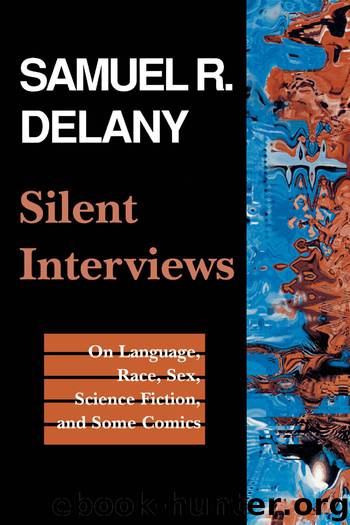Silent Interviews by Delany Samuel R.;

Author:Delany, Samuel R.;
Language: eng
Format: epub
Publisher: Wesleyan University Press
Published: 1994-03-13T16:00:00+00:00
5.
Some Real Mothers . . . :
The SF Eye Interview
This text began as an interview conducted and recorded by Takayuki Tatsumi at Luna- con, in Croton, New York, in April 1987. I rewrote the transcription over the next month. It was published in a 1987 issue of Science Fiction Eye (Volume 1, Number 3), edited by Stephen P. Brown out of Washington, D. C.
The interview is dedicated to the memory of Alfred Bester (1913–1987)
Takayuki Tatsumi: Let me begin with a brief introduction. Last autumn [1986] it was very exciting to watch you teach science fiction—especially the cyberpunk writers—at Cornell University, where you were a senior fellow at Cornell’s Society for the Humanities, and I had a chance to sit in on your seminar. Chiefly, you focused on a comparison of John Varley and William Gibson, along with a psychoanalytic reading of their works, giving us an insight into what’s going on in the current history of science fiction. Today I’d like to discuss with you your thoughts on cyberpunk, and SF after cyberpunk, based on your experiences at Cornell. To begin with, let me ask you, how did you like Cornell?
Samuel R. Delany: Well, it was a wonderful experience. It gave me a chance to talk about some ideas that had been percolating down for a year or more. Also, it was just a chance to think.
Paradoxically, the one thing that professional writers—writers who earn their living from their work—are not encouraged to do is think.
I don’t mean thinking about your work—how to make it better; how a sentence might be interpreted; how a story might be read; what you can use in everything from your afternoon walk by the grocery to the TV movie you catch at three in the morning. That’s the way a hunter thinks about hunting, or a dry cleaner thinks about cleaning fluids. It has too much the mark of necessity and survival.
I mean thinking as an abstract process, where, in a social situation, problems—or even situations—are put before you, and, in discussion or alone, you’re encouraged just to think about them. Since I’ve come back [from Cornell], I’ve finished one long story (or short novel), “The Tale of Rumor and Desire,” that is part of a new Nevèrÿon book, Return to Nevèrÿon. I couldn’t tell you directly how much of the Cornell experience went into it.
The landscape did.
There’s one scene in a gorge, which is primarily one of the Ithaca gorges (at Treeman Park) transformed a bit.
IT: The influence of landscape upon literature is very intriguing. However, J. G. Ballard’s “inner space” seems quite different from Gibson’s “cyberspace”; Ballard’s springs from his own experience in China; cyberspace functions both as the product of a high-tech imagination and as the playground for a certain stylistic experimentation. In this sense you were right when, in class, you compared Gibson’s cyberspace to Alfred Bester’s typographic experiments that configured Gully Foyle’s synesthesia while he space-time jaunted in The Stars My Destination. Could you tell me a little bit
Download
This site does not store any files on its server. We only index and link to content provided by other sites. Please contact the content providers to delete copyright contents if any and email us, we'll remove relevant links or contents immediately.
| African-American Studies | Asian American Studies |
| Disabled | Ethnic Studies |
| Hispanic American Studies | LGBT |
| Minority Studies | Native American Studies |
Cecilia; Or, Memoirs of an Heiress — Volume 1 by Fanny Burney(32434)
Cecilia; Or, Memoirs of an Heiress — Volume 2 by Fanny Burney(31871)
Cecilia; Or, Memoirs of an Heiress — Volume 3 by Fanny Burney(31852)
The Great Music City by Andrea Baker(31348)
We're Going to Need More Wine by Gabrielle Union(18967)
All the Missing Girls by Megan Miranda(15565)
Pimp by Iceberg Slim(14393)
Bombshells: Glamour Girls of a Lifetime by Sullivan Steve(13972)
Talking to Strangers by Malcolm Gladwell(13222)
Norse Mythology by Gaiman Neil(13204)
Fifty Shades Freed by E L James(13157)
For the Love of Europe by Rick Steves(12977)
Mindhunter: Inside the FBI's Elite Serial Crime Unit by John E. Douglas & Mark Olshaker(9200)
Crazy Rich Asians by Kevin Kwan(9167)
The Lost Art of Listening by Michael P. Nichols(7406)
Enlightenment Now: The Case for Reason, Science, Humanism, and Progress by Steven Pinker(7228)
The Four Agreements by Don Miguel Ruiz(6630)
Bad Blood by John Carreyrou(6552)
Weapons of Math Destruction by Cathy O'Neil(6143)
